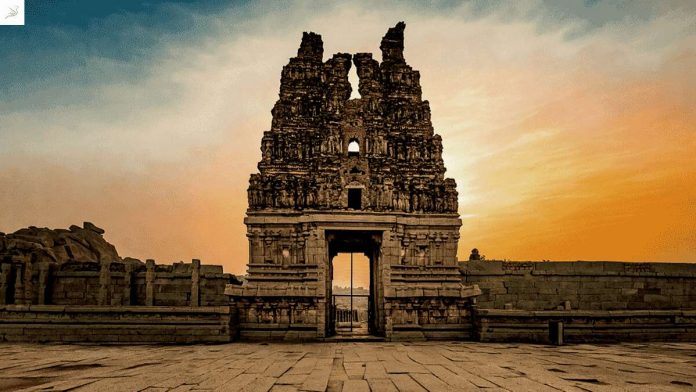Here, we’ll be doing a meticulous research over the state which is noted for its varied religious traditions along with their renowned history that has helped the state and the people in achieving a rich cultural heritage. KARNATAKA is known for its tradition and scenic beauty with places like Mysore, Hampi and Pattadakallu. Karnataka is a beautiful land blessed with timeless monuments, world heritage sites, luscious green forest, marvellous wildlife, romantic hill stations, stunning beaches and vibrant cultures.
Do you know which palace is the second most visited tourist destination in India? From which state, the brilliant Shakuntala Devi hails?
So, let’s content your eagerness by studying in detail about this exotic state, but before that have a look at the state symbols –
| State Capital | Bangalore |
| State Animal | Asian Elephant |
| State Bird | Indian Roller |
| State Flower | Lotus |
| State Tree | Sandalwood |
| State Dance | Dollu Kunitha |
| State CM (Present) | B.S. Yediyurappa |
| State Governor (Present) | Vajubhai Vala |
Of all the characteristic features, the one which sets the state apart is the culture of Karnataka. So, let’s look into its culture.
Table of Contents
CULTURE & Traditions of Karnataka
The culture of Karnataka is so vibrant that it adds new flavour to its very own existence. The local customs, dances and traditions add new vibe to the state of Karnataka.
- The official language of the state of Karnataka is Kannada. Almost 30% of the state has been taken over by the Kannadigas. The rest of Karnataka has been taken over by the Tuluvas, Konkinas and Kodavas. Almost 74% of people in Karnataka speak Kannada as a native language. Other languages spoken here are Tulu, Konkani, Kodava, Urdu, Hindi and English.
- Karnataka is a treasure house of ritualistic dances. The word Kunitha is used for all folk dances or ritual dances.
- Dollu Kunitha is a popular drum dance of Karnataka. Accompanied by singing, it provides spectacular variety and complexity of skills. Woven around the presiding deity of Beereshwara, chiefly worshipped by Kuruba Gowdas of Karnataka and also called Halumathasthas.
- Among the classical dances, the Mysore style of Bharatanatyam is the oldest and most popular form of classical dance in India.
- Other mainstream classical dances of Karnataka are Kuchipudi and Kathak.
- Yakshagana is one of the most difficult dances. It has no script and its performance depends solely on the artist’s ability. Another amazing Karnataka traditional dance form is Damman dance of Siddi community.
- Indian classical music has a special place for Karnataka as both Karnatak (Carnatic) and Hindustani styles find a place in the state. It is the only state where Hindustani Music from the north and Carnatic music from the south can be found together. Karnataka has produced great music artists like Bhimsen Joshi, Mallikarjuna Mansur, Kumar Gandharva, Basavaraj, and Puttaraj Gowai. Some of them have been a recipient of Kalidas Samman, Padma Bhushan and Padma Vibhushan awards.
- Karnataka is marked by some of the most colourful festivals.
- Mysore Dussehra is organized as Nada Habba, is the main festival of Mysore.
- The second important festival of Ugadi (Kannada New Year), while other festivals celebrated are Makar Sankranti (the Harvest Festival), Ganesh Chaturthi, Nagapanchmi, Basava Jayanti, Deepavali and Ramzan.
- Mysore Dasara, popularly known as Navratri, a ten-day festival in honour of the Hindu goddess Chamundeshwari which can be traced back to 15th century.
- Kambala is an epic buffalo race which is an annual two-day festival, Kambala season generally starts in November and lasts until March. It is an integral part of the rural community and is considered a sport as well as a tradition. Earlier, the rewards used to be coconuts, but these have been replaced by medals in recent times. The festival can be traced back over 800 years and is celebrated to please Lord Kadri Manjunatha, an incarnation of Lord Shiva.
- The dressing of Karnataka people varies from district to district.
- The main Kannadiga male costume is Panchey or Lungi, Angi and Peta. Panchey or Lungi is tied below the waist while Angi is a traditional shirt and Peta is a turban worn in Mysuru style or Dharwad style. Shyla is a piece of long cloth used to carry on the shoulder.
- Female costume includes Sari among which Ilkal Saris are woven using a special technique called Tope Teni. Mysore Silk saree is also famous. Salwar Kameez is widely popular in urban areas.
- Young women traditionally wear Langa Davani. Kasuti is a form of embroidery work which is very popular sought-after art on dresses and costumes. Jeans are popular among the youth, while new age Khadi/silk printed with various art are also found.
- Karnataka is known for its wide variety of dosa and sambhar. Rice is the staple food of Karnataka.
- A typical Kannadiga Oota (Meal) consists of rice, sambhar, pickle, ghee, dessert and other curry-based dishes served on a banana leaf.
- Other popular dishes include the Neer Dosa, Bisi Bele Bhaat (a lot like a khichdi) and Chicken Curry known as Korri Gassi. Coconut and fruits are staple elements of these dishes.
- A signature dish of Southern Karnataka is the kori rotti. It consists of a thin wafer-like rotti made from rice, dipped in chicken curry. This is the traditional dish of Tuluvas. Coconut paste is an important element of the dish, and the curry itself is made up of versions of milder curries.
- In dessert, they use milk, vermicelli, sugar, coconuts, jaggery and dry fruits. Payasas, pedas of different types, kesari bhath and chiroti are some of the popular deserts of Karnataka.
- A Kannada wedding is pretty much similar to that of a typical Hindu wedding. Nandi Pooja is done pre-wedding to ensure the ceremony goes smoothly without any glitches. It is followed by a fascinating ritual Kashi Yatra, where the groom pretends to go on a pilgrimage saying that the family doesn’t find a bride for him. The wedding starts with the Mandap Puja to cleanse the venue followed by the Var Puja and the Dhare ceremony. The most important part of every wedding is the Sapthapadi where the bride and groom walk around in a circle with the holy fire at the centre of it seven times while chanting the vows of marriage.
The geography of Karnataka boasts of a wide variety of flora and fauna that are spread throughout its length and breadth.
GEOGRAPHY
The state of Karnataka is blessed with the bounty of nature which is manifested in the splendid “Topography” of the region. Covered with the luxuriant evergreen forest, the mighty Sahyadris adds to the natural beauty of the state of Karnataka.
- Latitudinal Extension – 110 30’ to 180 30’ N
- Longitudinal Extension – 740 to 780 30’ E
- Area – 1,91,791 km2
Rank in India – 6th
- Population – 61,130,704
Rank in India (According to the 2011 census) – 8th
- Boundaries – The state is bordered by the Arabia Sea to the west, Goa to the northwest, Maharashtra to the north, Telangana to the northeast, Andhra Pradesh to the east, Tamil Nadu to the southeast and Kerala to the south.
- Literacy Rate (According to the 2011 census) – 75.36%
- The name Karnataka is derived from Karunadu which means ‘Lofty lands”.
- Mullayyanagiri (in Western Ghats) is the highest peak of Karnataka with an altitude of 1930 metres.
- The two important river systems are Krishna and Kaveri. Both these Rivers flow out of Karnataka eastwards to the Bay of Bengal. The Kaveri rises at Talakaveri on the Brahmagiri range in the Western Ghats, Kodagu district of the state of Karnataka, at an elevation of 1314 m about mean sea level and flows for 800 km before its outfall into Bay of Bengal. It is the third largest river – after Godavari and Krishna in South India and the largest in Tamil Nadu, which on its course, bisects the state into North and South. The Kaveri is a sacred river to the people of South India and is worshipped as Goddess Kaveramma. The Kaveri is also one of the seven holy rivers of India.
- The state can be divided into four physiographic landforms – the Northern Karnataka Plateau, the Central Karnataka, the Southern Karnataka Plateau and the Coastal Karnataka Region.
- Climate – Karnataka has dynamic weather due to the land’s altitude, topography and distance from the sea.
- The climate of Karnataka ranges from arid to semi-arid to humid tropical. Two annual monsoons bring rainfall to Karnataka: The North-East Monsoon and The South-West Monsoon. The mean annual rainfall in Karnataka is around 1355 mm.
- The coastal region of Karnataka receives the maximum rainfall while parts of North Interior Karnataka are among the major rainfall deficit areas of the state.
- Summer starts from the month of March and extends till May. This season is hot, dry and humid.
- Monsoon begins in June and lasts until September. During this season the state receives rainfall due to the southwest monsoon winds.
- Post-Monsoon season extends from October to December. This season is quite pleasant as humidity reduces significantly.
- Winter stays in Karnataka during the months of January and February. The state experiences low temperature and reduces humidity.
- Soil – The north-western part of the state is characterized more by its soil than by its relief. In this region, underlying volcanic rock produces a soil known as Regur, the humus-rich, cotton-growing black soil of India. By contrast, the soils of the adjacent Karnataka Plateau are generally porous and infertile, except in river basins, where they are loamy and somewhat fertile. Soils in the coastal plain include iron-rich clays in the inland areas and sandy alluvial deposits toward the coast itself.
Karnataka is a state belonging to South-West India with a democratic government running the state. So, let’s explore the last aspect i.e.-
POLITY
The government of Karnataka, like that of most other states and territories in India, is determined by the national constitution of 1950.
- Politics in Karnataka has been dominated by three political parties, the Indian National Congress, the Janata Dal (Secular) and the Bharatiya Janta Party. The Janata Dal (Secular) and the Indian National Congress led coalition government was in power from May 2018 till July 2019.
- Karnataka is one of the few Indian states with a bicameral legislature, consisting of a Legislative Assembly (Vidhan Sabha) of 224 strength of directly elected members and a Legislative Council (Vidhan Parishad) of 75 strength, members of which are elected variously by the Legislative Assembly, by local leaders and by teachers and by graduates.
- The state High Court is the Karnataka High Court, which is subordinate to the Supreme Court in New Delhi. It consists of a chief justice, the present one is Abhay Shreeniwas Oka.
- The state is divided into more than two dozen districts i.e. 30, which are grouped into four divisions. Each district is headed by a deputy commissioner, who also serves as the district magistrate and collector.
- Representation in Parliament –
Lok Sabha – 28
Rajya Sabha – 12
- The Present and 19th CM is B.S. Yediyurappa. He is serving for the fourth time, the only CM to do so in the history of Karnataka and he is also the only person in the history of Karnataka to serve three times as Leader of Opposition in the Karnataka Legislative Assembly.
- Vajubhai Vala is presently serving as the Governor of Karnataka since September 2014. He is still a member of the Bharatiya Janta Party.
- First CM – K.Chengalaraya Reddy (4 May 1902 – 27 February 1976)
First Governor – Jayachamarajendra Wadiyar (1 November 1956 – 4 May 1963)
Now, Some Interesting Facts about Karnataka are –
- Shakuntala Devi, who is famously known as Human Computer for her skills in Mathematics, Puzzles and Astrology hails from Bangalore.
- Mysore Palace is the second most visited tourist destination of India after Taj Mahal. It was built by Krishnarajendra Wadiya IV in 1912.
- The district of Vijaypura, also known as Bijapur within the state of Karnataka, witnesses the flow of five rivers passing through it including the tributaries of Krishna, Doni, Bhima, Ghataprabha and Malaprabha. The district is also known as the ‘Five Rivers Land’.
- The Karanji Lake of Mysore is renowned for its walk-through aviary, which is the largest aviary in India. Surrounded by beautiful delights, this aviary is a popular tourist destination.
- The state of Karnataka sustains its winning streak of the prestigious Jnanpith Literary awards with a maximum number of awardees nominated from the state. Karnataka has won a total of 8 Jnanpith Literary awards.
- Karnataka is the largest coffee exporter in the country. With beautiful tea plantations, the state of Karnataka also has a large number of coffee consumers.
Well, hope you must be astonished by the facts and aspects of the state. For more such content, stay tuned because the next part will be dealing with the state’s history, education, environment, sports and economy.
Do you know who was the first woman to lead an armed rebellion against the British? Which state is the hub of IT industry?
More of such questions will be crystal cleared in the upcoming part. If you don’t want to miss it, click here – Know your State ‘Karnataka’ – Part 2. Hope these blogs help you attempting the various competitive exams such as CDS, RRB NTPC, BANK PO, SSC CGL, etc.
Thank You




